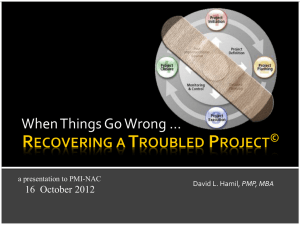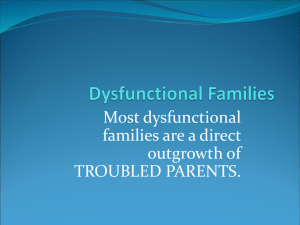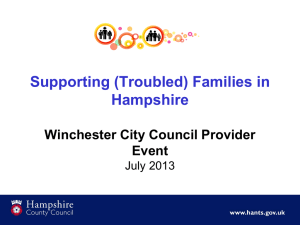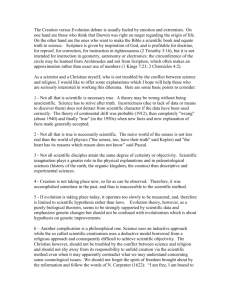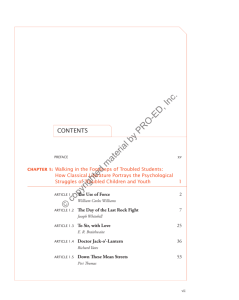Tax-Exempt Organizations/Health Care Alert New Changes to State Payment System May
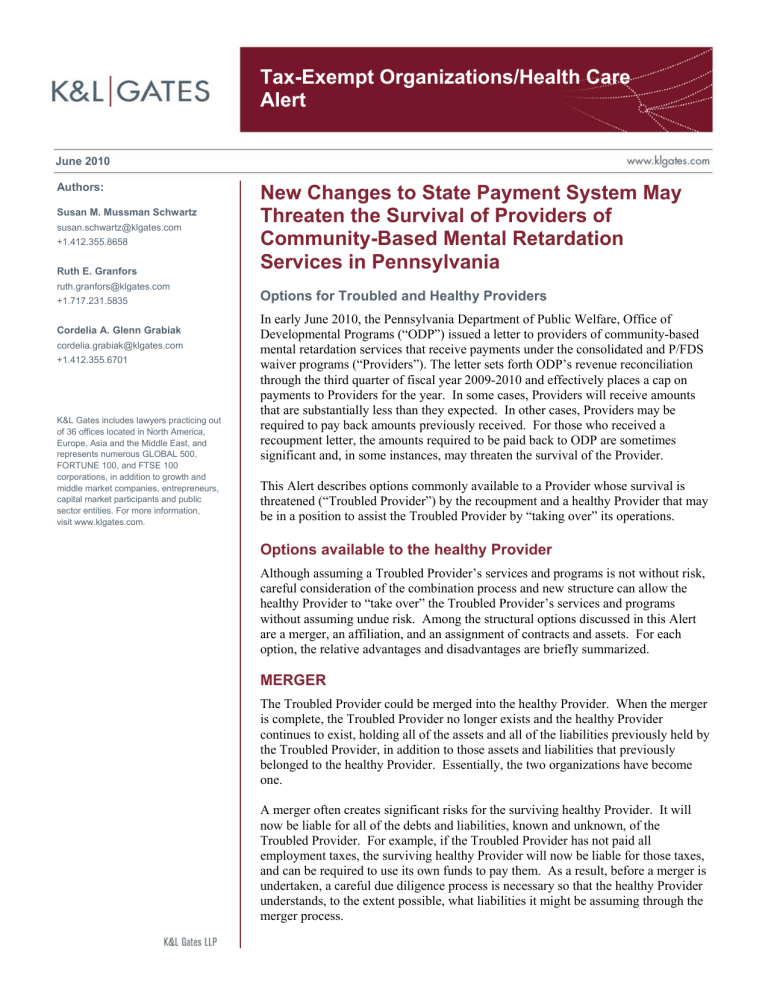
Tax-Exempt Organizations/Health Care
Alert
June 2010
Authors:
Susan M. Mussman Schwartz susan.schwartz@klgates.com
+1.412.355.8658
Ruth E. Granfors ruth.granfors@klgates.com
+1.717.231.5835
Cordelia A. Glenn Grabiak cordelia.grabiak@klgates.com
+1.412.355.6701
K&L Gates includes lawyers practicing out of 36 offices located in North America,
Europe, Asia and the Middle East, and represents numerous GLOBAL 500,
FORTUNE 100, and FTSE 100 corporations, in addition to growth and middle market companies, entrepreneurs, capital market participants and public sector entities. For more information, visit www.klgates.com.
New Changes to State Payment System May
Threaten the Survival of Providers of
Community-Based Mental Retardation
Services in Pennsylvania
Options for Troubled and Healthy Providers
In early June 2010, the Pennsylvania Department of Public Welfare, Office of
Developmental Programs (“ODP”) issued a letter to providers of community-based mental retardation services that receive payments under the consolidated and P/FDS waiver programs (“Providers”). The letter sets forth ODP’s revenue reconciliation through the third quarter of fiscal year 2009-2010 and effectively places a cap on payments to Providers for the year. In some cases, Providers will receive amounts that are substantially less than they expected. In other cases, Providers may be required to pay back amounts previously received. For those who received a recoupment letter, the amounts required to be paid back to ODP are sometimes significant and, in some instances, may threaten the survival of the Provider.
This Alert describes options commonly available to a Provider whose survival is threatened (“Troubled Provider”) by the recoupment and a healthy Provider that may be in a position to assist the Troubled Provider by “taking over” its operations.
Options available to the healthy Provider
Although assuming a Troubled Provider’s services and programs is not without risk, careful consideration of the combination process and new structure can allow the healthy Provider to “take over” the Troubled Provider’s services and programs without assuming undue risk. Among the structural options discussed in this Alert are a merger, an affiliation, and an assignment of contracts and assets. For each option, the relative advantages and disadvantages are briefly summarized.
MERGER
The Troubled Provider could be merged into the healthy Provider. When the merger is complete, the Troubled Provider no longer exists and the healthy Provider continues to exist, holding all of the assets and all of the liabilities previously held by the Troubled Provider, in addition to those assets and liabilities that previously belonged to the healthy Provider. Essentially, the two organizations have become one.
A merger often creates significant risks for the surviving healthy Provider. It will now be liable for all of the debts and liabilities, known and unknown, of the
Troubled Provider. For example, if the Troubled Provider has not paid all employment taxes, the surviving healthy Provider will now be liable for those taxes, and can be required to use its own funds to pay them. As a result, before a merger is undertaken, a careful due diligence process is necessary so that the healthy Provider understands, to the extent possible, what liabilities it might be assuming through the merger process.
Tax-Exempt Organizations/Health Care Alert
In addition, consideration must be given to the impact of the merger upon the tax-exempt status (if any) of the healthy Provider or even retroactive effects upon the tax-exempt status of the Troubled
Provider. If one or both of the Providers is a taxexempt organization, Attorney General approval of the merger will be required and Orphans’ Court approval may be required. New licenses may also be necessary.
The main advantage of a merger is the ease of administration once the merger is complete.
Because the two organizations have become one, there will only be one board of directors, one tax return, one audit, etc. Some planning and negotiation, however, will be required to determine how to combine the boards of directors (if at all) and to address staffing and other operational issues resulting from the combination.
In sum, although a merger provides for ease of administration once complete, before merging with a
Troubled Provider, it is critical that the healthy
Provider undertake sufficient due diligence to understand the potential risks associated with a merger.
AFFILIATION
Often the healthy Provider finds an affiliation to be more attractive than a merger because it enhances the capacity of the healthy Provider to minimize the risk associated with the new relationship.
Typically, the affiliation involves the Troubled
Provider granting to the healthy Provider (or one of its affiliates) certain control rights. After the affiliation, the healthy Provider typically elects a majority of the directors of the Troubled Provider, has the right to approve all changes to its bylaws, the right to approve fundamental changes (e.g. mergers, dissolution, amendment of articles of incorporation, etc.) and perhaps other rights such as the right to approve budgets and transactions outside of the ordinary course of business. In effect, a parent- subsidiary relationship is established. The precise manner of accomplishing an affiliation varies depending upon whether the Providers are for-profit or nonprofit Providers. For a nonprofit corporation, an affiliation can be accomplished by amending governing corporate documents. For a for-profit
Corporation, an affiliation can be accomplished via a sale of stock.
After the affiliation is complete, both the Troubled
Provider and the healthy Provider continue to exist, each with its own board of directors. Accordingly, even though the healthy Provider (or one of its affiliates) controls the Troubled Provider, the healthy Provider is not liable for all of the debts and torts of the Troubled Provider so long as the appropriate corporate formalities are observed, the finances are handled appropriately and the healthy
Provider does not guaranty or otherwise contractually obligate itself for the liabilities of the
Troubled Provider. Post-affiliation, the Troubled
Provider can operate more efficiently because many duplicative costs (e.g. executive director, human resources, accounting, etc.) can be eliminated through a management and administrative services agreement between the two organizations. In many cases, the healthy Provider will provide financial assistance to the Troubled Provider for a while. By using an affiliation rather than a merger, the healthy
Provider can assist only to the extent it deems appropriate to do so.
The level of due diligence advisable for an affiliation is less than that for a merger because the risk is less. Orphans’ Court approval likely will not be required and it is often possible to limit Attorney
General involvement to a notice. Because a hearing is not required, it is usually possible to accomplish an affiliation more quickly than a merger.
Licensing issues, however, may still affect timing.
Overall, an affiliation provides for greater protection for the healthy Provider and can be accomplished more quickly than a merger. In exchange for those benefits, however, the Providers will have a more complex structure to maintain.
ASSIGNMENT OF CONTRACTS AND
ASSETS
It is also possible for the Troubled Provider simply to assign its contracts and related assets to the healthy Provider. Sometimes, the contracts with the
Troubled Provider are simply terminated and new ones are established with the healthy Provider.
Whether or not assignment is permitted to accomplish a transfer of the business depends on the language of contracts to be assigned and any regulatory approvals that are precedent to entering such a contract. For example, the two-page provider agreement between a Provider and ODP
June 2010 2
Tax-Exempt Organizations/Health Care Alert
does not permit or prohibit assignment. Under
Pennsylvania common law, assignment of the contract should be permitted when the contract does not address the issue. Because the ODP provider agreement is in the nature of a governmental approval, however, the healthy Provider should notify ODP of the contemplated assignment of the
Troubled Provider’s contracts. Questions such as whose reimbursement rates govern for the services under those contracts and whether the healthy
Provider adopts the revenue target for those services would need to be explored. The same questions need to be considered with respect to potential assignment of county-based contracts. Of course, any licenses required in order to provide the services under these contracts are not automatically transferred, so the healthy Provider may need to obtain licenses to provide the new services.
In addition, it typically will be necessary to arrange for assignments of leases of the real property used for residential services. If the Troubled Provider owns the real property, a transfer of the real property to the healthy Provider will result in the imposition of real property transfer taxes. (Such taxes do not usually accompany a merger or an affiliation). If the
Troubled Provider will remain in existence, it may be possible to avoid the transfer taxes by having the
Troubled Provider lease the real property to the healthy Provider.
An assignment is sometimes used when a merger or affiliation presents too great a risk. In any event, careful attention to contract terms is necessary to control risk.
Options Available to a Troubled
Provider
Each of the options described above is also available to the Troubled Provider. In the case of the merger and affiliation options, it is necessary that the
Troubled Provider identify a healthy Provider interested in the arrangement. When the assignment option is selected, the Troubled Provider will need to liquidate and dissolve or undertake new activities. If the Troubled Provider is a nonprofit corporation, the dissolution process will involve the Attorney
General and may also require an Orphans’ Court hearing. In any event, it will be necessary for a dissolving Troubled Provider to liquidate its assets and file a final tax return. The amount of effort necessary to liquidate and dissolve is usually surprising to organizations that find it necessary to do so.
Sometimes a Troubled Provider is successful in extracting from the healthy Provider an agreement to operate in a certain way for a short time in the future. For example, the healthy Provider might agree to place certain persons from the Troubled
Provider on the board of the healthy Provider (or one of its affiliates); the healthy Provider might agree to continue a certain program for a period of time. It is important for the Troubled Provider to remember that such promises can be difficult to enforce once the merger or affiliation or assignment is complete. Accordingly, thought should be given to the enforcement process when the agreement is negotiated.
A Troubled Provider may find some relief in the bankruptcy process, particularly if it is being pursued aggressively by creditors. In addition, the
Pennsylvania Nonprofit Corporation Law allows for the appointment of a receiver to oversee the liquidation of the nonprofit corporation. This process can be helpful when the dissolving nonprofit corporation does not have sufficient assets to pay all of its creditors.
CONCLUSION
There are many ways that a healthy Provider can
“take over” the operations of a Troubled Provider in a manner that allows the continuation of services to the clients of the Troubled Provider. This Alert summarizes very generally some of the alternatives commonly used but does not address all of the possibilities or associated issues. It is critical that any Provider interested in such an arrangement work closely with knowledgeable legal counsel so as to protect the healthy Provider to the extent possible, thereby maximizing the likelihood that the important services provided by Providers are not interrupted.
June 2010 3
Tax-Exempt Organizations/Health Care Alert
Anchorage Austin Beijing Berlin Boston Charlotte Chicago Dallas Dubai Fort Worth Frankfurt Harrisburg Hong Kong London
Los Angeles Miami Moscow Newark New York Orange County Palo Alto Paris Pittsburgh Portland Raleigh Research Triangle Park
San Diego San Francisco Seattle Shanghai Singapore Spokane/Coeur d’Alene Taipei Tokyo Warsaw Washington, D.C.
K&L Gates includes lawyers practicing out of 36 offices located in North America, Europe, Asia and the Middle East, and represents numerous
GLOBAL 500, FORTUNE 100, and FTSE 100 corporations, in addition to growth and middle market companies, entrepreneurs, capital market participants and public sector entities. For more information, visit www.klgates.com.
K&L Gates is comprised of multiple affiliated entities: a limited liability partnership with the full name K&L Gates LLP qualified in Delaware and maintaining offices throughout the United States, in Berlin and Frankfurt, Germany, in Beijing (K&L Gates LLP Beijing Representative Office), in
Dubai, U.A.E., in Shanghai (K&L Gates LLP Shanghai Representative Office), in Tokyo, and in Singapore; a limited liability partnership (also named
K&L Gates LLP) incorporated in England and maintaining offices in London and Paris; a Taiwan general partnership (K&L Gates) maintaining an office in Taipei; a Hong Kong general partnership (K&L Gates, Solicitors) maintaining an office in Hong Kong; a Polish limited partnership (K&L
Gates Jamka sp. k.) maintaining an office in Warsaw; and a Delaware limited liability company (K&L Gates Holdings, LLC) maintaining an office in
Moscow. K&L Gates maintains appropriate registrations in the jurisdictions in which its offices are located. A list of the partners or members in each entity is available for inspection at any K&L Gates office.
This publication is for informational purposes and does not contain or convey legal advice. The information herein should not be used or relied upon in regard to any particular facts or circumstances without first consulting a lawyer.
©2010 K&L Gates LLP. All Rights Reserved.
June 2010 4
